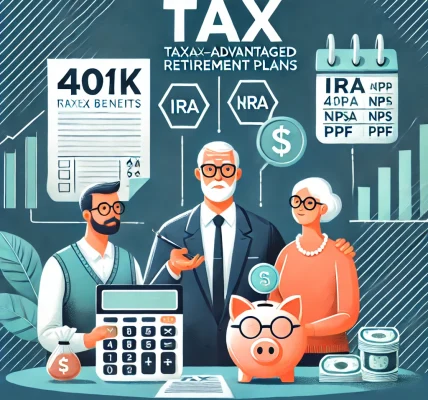Introduction
Retirement planning is one of the most crucial aspects of financial well-being. Many people wonder, “How early should I start saving for retirement?” The simple answer is: as early as possible. The earlier you start, the more you can benefit from compound interest, tax advantages, and financial security in later years.
This detailed guide will explore the ideal time to start saving, the benefits of early saving, how much you should save at different life stages, and strategies to maximize your retirement savings.
1. Why Should You Start Saving for Retirement Early?
a) The Power of Compound Interest
Compound interest is often called the “eighth wonder of the world.” The longer your money stays invested, the more it grows exponentially.
Example: If you start investing $200 per month at age 25 with an average return of 7% per year, you could have $528,000 by age 65. If you start at age 35, you’d have only $245,000—less than half!
b) More Time to Recover from Market Fluctuations
Markets have ups and downs, but starting early gives you time to recover from any downturns, unlike those who start saving closer to retirement age.
c) Less Financial Stress in Later Years
If you start early, you can contribute smaller amounts over a longer period instead of saving aggressively in your 40s or 50s, which can be financially overwhelming.
d) Opportunity for Higher Returns
Long-term investments, such as stocks and mutual funds, tend to yield higher returns over decades compared to short-term investments.
2. How Much Should You Save at Different Life Stages?
a) In Your 20s: Laying the Foundation
- Start saving at least 10-15% of your income.
- Contribute to employer-sponsored retirement plans like a 401(k) or pension plan.
- Open an IRA (Individual Retirement Account) for additional savings.
- Focus on growth-oriented investments like stocks and equity funds.
- Build an emergency fund to avoid dipping into retirement savings.
b) In Your 30s: Accelerating Contributions
- Increase savings to 15-20% of income.
- Take advantage of employer-matching contributions in a 401(k).
- Diversify your investments (stocks, bonds, and real estate).
- Consider tax-advantaged accounts like a Roth IRA.
- Avoid lifestyle inflation—keep expenses under control and invest extra income.
c) In Your 40s: Catching Up if Needed
- If you haven’t started yet, aim for 20-25% of your income.
- Max out 401(k) and IRA contributions.
- Start shifting towards balanced investments to reduce risk.
- Reduce debts, including mortgages and personal loans.
- Consider catch-up contributions (extra savings allowed for those over 50).
d) In Your 50s and 60s: Preparing for Retirement
- If behind, increase contributions to 30% or more of income.
- Shift investments toward low-risk assets like bonds and annuities.
- Plan for healthcare and long-term care costs.
- Avoid withdrawing from retirement accounts early to maximize benefits.
3. Best Retirement Savings Strategies
a) Take Advantage of Employer-Sponsored Plans
If your employer offers a 401(k) plan, contribute enough to get the full employer match—it’s free money!
b) Use Tax-Advantaged Accounts
- Traditional IRA: Contributions are tax-deductible, but withdrawals in retirement are taxed.
- Roth IRA: Contributions are made after tax, but withdrawals in retirement are tax-free.
- 401(k) or 403(b): Tax-deferred retirement accounts offered by employers.
c) Automate Your Savings
Set up automatic transfers to retirement accounts so you consistently save without having to think about it.
d) Diversify Your Investments
Don’t rely on just one asset type. A mix of stocks, bonds, mutual funds, and real estate can help maximize returns while minimizing risks.
e) Avoid Early Withdrawals
Withdrawing from retirement accounts early results in penalties and taxes, significantly reducing your savings.
4. Common Mistakes to Avoid
a) Delaying Retirement Savings
Many people delay saving, thinking they will “catch up later.” This approach leads to financial stress in later years.
b) Not Taking Full Advantage of Employer Matches
If your employer offers a 401(k) match and you don’t contribute enough, you are leaving free money on the table.
c) Investing Too Conservatively When Young
Investing in low-risk assets too early can result in lower returns. Younger individuals should invest in growth-focused assets.
d) Withdrawing Retirement Savings Prematurely
Avoid withdrawing from your retirement accounts for non-emergency expenses. Early withdrawals come with penalties and lost growth potential.
5. How to Stay on Track with Your Retirement Savings
a) Set Clear Retirement Goals
Define how much money you’ll need in retirement based on lifestyle, inflation, and healthcare costs.
b) Regularly Increase Your Contributions
As your income grows, increase the percentage of your savings contributions.
c) Monitor and Adjust Investments
Review your portfolio periodically and adjust it according to market trends and retirement goals.
d) Work with a Financial Advisor
A financial advisor can help tailor a retirement savings plan that aligns with your financial situation and goals.
6. Conclusion
The best time to start saving for retirement is NOW. Whether you’re in your 20s, 30s, or beyond, the earlier you begin, the more financial security you’ll have in retirement.
✅ Start early to take advantage of compound interest. ✅ Save consistently and increase contributions over time. ✅ Utilize tax-advantaged accounts like 401(k) and IRA. ✅ Avoid unnecessary withdrawals and maintain a long-term mindset. ✅ Diversify investments to balance risk and growth.
Planning for retirement may seem overwhelming, but taking small, consistent steps today will ensure a comfortable and stress-free future. Start now, and give yourself the financial freedom to enjoy your golden years!




